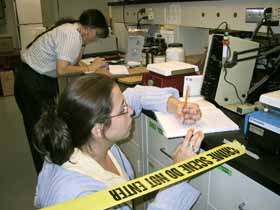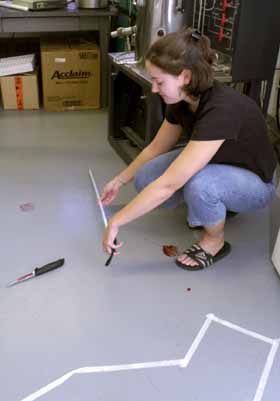|
This is an archived article.
For the latest news, go to the Advance
Homepage
For more archives, go to the Advance Archive/Search Page. |
||||
|
Innovative Approach to Teaching Science
Uses Hands-on Methods By Janice Palmer
of the United Technologies Engineering Building. Yellow crime scene tape hangs across the door to the fermentation laboratory. Inside is the outline of a body sprawled across the floor. A blood-smeared knife lies nearby. A suspicious white powder is heaped on the floor next to the desk, and a white lab coat with a bloody slash across the right shoulder hangs off the back of a chair.
This is not a scene from the latest episode of the television show, CSI: Crime Scene Investigation. It is a new graduate-level elective offered by the Neag School of Education called "Teaching the Nature of Science." The investigators are prospective science teachers. They are in the fifth year of the Integrated Bachelor's/Master's teacher preparation program, and next year will be teaching in classrooms around Connecticut. The course is a collaborative effort between David Moss, an assistant professor in the Department of Curriculum and Instruction and Robert Vieth, a research scientist in the Biotechnology Center. "Teaching the Nature of Science" is one of the first of its kind in the country to blend science and the philosophy of science for pre-service teachers in this way. Research on the effectiveness of this class is expected to impact the science education community engaged in the reform of preparing science teachers. "Problem-solving scenarios, like the crime scene investigation, provide students with a context for learning the nature of science," Moss says. His research shows that most students and teachers do not have a broad understanding of the sciences. In his words, "Many are not science literate." Traditional science education has been focused on pushing kids with a talent for the subject to memorize formulas and theories without context or meaning. Students are directed to find the "one right answer" during a lab experiment. The longtime belief, Moss said, has been students would learn the nature of science implicitly. But an overwhelming amount of research in public schools by the UConn educator and others find that an explicit reflective approach may be far more effective. Even doing science does not automatically translate to learning about science unless time is set aside to bring the nature of science to the surface. By using a project-based curriculum, students are encouraged to think for themselves and to use deductive reasoning and analytical skills while creatively solving a problem. This strategy will help students become scientifically literate, he says. "People who graduate from high school are often unable to participate in a conversation about science and technology," laments Moss. "We need people who can understand the importance of funding space exploration and protecting the environment. They need a broader picture of what science is about and to be able to determine the validity of research while making informed decisions that affect their lives." And since he believes in practicing what he preaches, Moss' new course models a project-based curriculum designed to inspire his students to question the kind of content they should be teaching and in what context they should be teaching it. For the first couple of weeks, Moss's students have been reading, writing and discussing the public's misconceptions and misunderstanding s about science theory and research. In another class, students are told to put on latex gloves and are sent to a mock crime scene where they collect and bag evidence. A week later, they conduct a series of tests to analyze the evidence. This week, students will gather to analyze their experiences, observations and test results as they determine "who dun it." "They are experiencing first-hand what it is scientists do," Moss says. "And we hope they gain a better understanding of how scientists think." Moss has been preparing for this new course for nearly two years. With the help a $24,000 TALENT grant from the Connecticut Department of Higher Education, he is able to support a graduate student and buy the supplies Vieth needs for the various projects including the mock crime scene. Moss' students will be well prepared for the future. He is co-chair of a committee appointed by the Connecticut Department of Education to rewrite the state's science curriculum and assessment standards for K-12 schools, in which science literacy and an understanding of the nature of science are expected to play a major role in the new framework. |
 hings are afoot on the second floor
hings are afoot on the second floor

